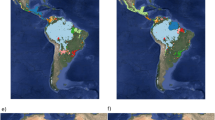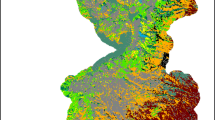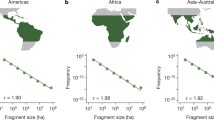Abstract
The spread of gallery forest habitat into upland areas is of substantial interest to resource managers because such spread has many implications for the management of grassland and forest habitats. This study used a dynamic percolation model to examine the potential rates of spread or invasion of forest in eastern Kansas. Aerial photos taken 16 years apart at the Fort Riley training base were used to calibrate a spatially explicit contagion model of forest spread to interpolate and extrapolate the forest spread processes. Results fit the actual pattern of spread well, as measured by both visual inspection and a multiscale fractal measure of pattern. Comparisons to a long-term fire-exclusion experiment in Geary County, Kansas, and to the Konza Prairie also provided validation. Both the simulation and the 100-year Geary County series showed an interesting pattern of forest spread. Spread was slow and steady until about 20% forest cover was reached, at which point the rate increased. We conclude that this self-accelerating response is due to spatial patterns created by the spreading forest that tend to accelerate the growth process after a critical point is reached. On the basis of theoretical study and experimental simulation of the percolation phase transitions, we suggest that fractal dimensions in a transient ecotone of binary mixtures (e.g., trees and grasses) should range between 1.56 and 1.8958, and the critical fractal dimension during ecotonal phase transitions should be 1.7951. This critical point of about 18.5% forest cover that we predicted was close to the observed result and might represent a phase transition at the forest-prairie ecotone.
Similar content being viewed by others
References
Abrams, M.D. 1986a. Historical development of gallery forests in northeast Kansas. Vegetatio 65: 29–37.
Abrams, M.D. 1986b. Ecological role of fire in gallery forests in eastern Kansas.In Symposium on Prescribed Burning in the Midwest: State of the Art, Stevens Point, WI, Mar. 3–6, 1986. pp. 73–80. Edited by A. Kroonce. University of Wisconsin, Stevens Point, WI.
Bragg, T.B. and Hulbert, L.C. 1976. Woody plant invasion of unbumed Kansas bluestem prairie. J. Range Management 29: 19–24.
Broadbent, S.R. and Hammersley, J.M. 1957. Percolation processes: Crystals and mazes. Proc. Camb. Phil. Soc. 53: 629–641.
Cardy, J.L. and Grassberger, P. 1985. Epidemic models and percolation. J. Physics A 18: L267-L271.
Casti, J. 1982. Catastrophes, control and the inevitability of spruce budworm outbreaks. Ecological Modelling 14: 293–300.
Cox, J.T. and Durrett, R. 1988. Limit theorems for the spread of epidemics and forest fires. Stochastic Processes and Their Applications 30: 171–191.
Flory, P.J. 1941. Molecular size distribution in three dimensional polymers (I–III). J. American Chemical Society 63: 3083–3100.
Gardner, R.H., Milne, B.T., Turner, M.G. and O'Neill, R.V. 1987. Neutral models for the analysis of broad-scale landscape patterns. Landscape Ecology 1: 19–28.
Gatto, M. and Rinaldi, S. 1987. Some models of catastrophic behavior of exploited forests. Vegetatio 69: 213–222.
Gosz, J.R. 1992. Ecological functions in biome transition zones: Translating local responses to broad-scale dynamics.In Landscape Boundaries: Consequences for Biotic Diversity and Landscape Flows. pp. 55–75. Edited by A.J. Hansen and F. di Castri. Springer-Verlag, New York.
Gosz, J.R. and Sharpe, J.H. 1989. Broad-scale concepts for interactions of climate, topography, and biota and biome transitions. Landscape Ecology 3: 229–243.
Grassberger, P. 1983. On the critical behavior of a general epidemic process and dynamic percolation. Mathematical Biosciences 63: 157–172.
Kay, J.J. and Schneider, E.D. 1992. Thermodynamics and measures of ecological integrity.In Ecological Indicators. pp. 159–182. Vol. 1. Edited by D.H. McKenzie, E.D. Hyatt and V.J. McDonald. Elsevier Applied Science, New York.
Knight, C.L., Briggs, J.M. and Nellis, M.D. 1994. Expansion of gallery forest on Konza Prairie research natural area, Kansas, USA. Landscape Ecology 9(2): 117–125.
Kotecky, R. (Ed.), 1993. Phase transitions: Mathematics, Physics, Biology. World Scientific, Singapore.
Kucera, C.L. 1960. Forest encroachment in native prairie. Iowa State J. Science 34: 635–640.
Kuulasmaa, K. 1982. The spatial general epidemic and locally dependent random graphs. J. Applied Probability 19: 745–758.
Kuulasmaa, K. and Zachary, S. 1984. On spatial general epidemics and bond percolation processes. J. Applied Probability 21: 911–914.
Lenormand, R. and Zarcone, C. 1985. Invasion percolation in an etched network: Measurement of a fractal dimension. Physical Review Letters 54: 2226–2229.
Li, B.L. 1995a. Stability analysis of a nonhomogeneous Markovian landscape model. Ecological Modelling, in press.
Li, B.L. 1995b. Fractal geometry applications in description and analysis of patch patterns and patch dynamics. Ecological Modelling, in press.
Li, B.L., Wu, Y. and Wu, J. 1992. Patchiness and patch dynamics II: Description and analysis. Chinese Journal of Ecology 11(5): 28–37.
Li, B.L., Chu, Y. and Loh, D.K. 1993. Event probability correlation analysis for comparison of two-phase ecological maps. Ecological Modelling 69: 287–302.
Li, B.L., Loehle, C. and Malon, D. 1995. Microbial transport through heterogeneous porous media: Random walk, fractal, and percolation approaches. Ecological Modelling (in press).
Loehle, C. 1989. Forest-level analysis of stability under exploitation: Depensation responses and catastrophe theory. Vegetatio 79: 109–115.
Loehle, C. and Wein, G. 1994. Landscape habitat diversity: A multiscale, information theory approach. Ecological Modelling 73: 311–329.
Loehle, C. and Li, B.L. 1995. Statistical properties of ecological and geologic fractals. Ecological Modelling (in press).
Ludwig, D.D., Jones, D. and Holling, C.S. 1978. Qualitative analysis of insect outbreak systems: The spruce budworm and the forest. Journal of Animal Ecology 44: 315–332.
McKay, G. and Jan, N. 1984. Forest fires as critical phenomena. J. Physics A 17: L757-L760.
Milne, B.T., Johnson, A.R., Keitt, T.H., Hatfield, C.A., David, J. and Hraber, P. 1995. Detection of critical densities associated with pinon-juniper woodland ecotones. Ecology (in press).
Mollison, D. 1977. Spatial contact models for ecological and epidemic spread. J. Royal Statistical Society B39: 283–326.
Mollison, D. 1986. Modelling biological invasions: Chance, explanation, prediction. Phil. Trans. Royal Society of London B 314: 675–693.
Mollison, D. and Kuulasmaa, K. 1985. Spatial epidemic models: Theory and simulations.In Population Dynamics of Rabies in Wildlife. pp. 291–309. Edited by P.J. Bacon. Academic Press, New York.
Ohtsuki, T. and Keyes, T. 1986. Biased percolation: Forest fires with wind. J. Physics A 19: L281-L287.
O'Neill, R.V., Johnson, A.R. and King, A.W. 1989. A hierarchical framework for the analysis of scale. Landscape Ecology 3: 193–205.
Rex, K.D. and Malanson, G.P. 1990. The fractal shape of gallery forest patches. Landscape Ecology 4: 249–258.
Risse, P.G. 1995. The status of the science examining ecotones. BioScience 45(5): 318–325.
Sahimi, H. 1994. Applications of Percolation Theory. Taylor & Francis, London.
Stauffer, D. 1985. Introduction to Percolation Theory. Taylor & Francis, London.
Stinchcombe, R.B. 1990. Fractals, phase transitions and criticality.In Fractals in the Natural Sciences. pp. 17–33. Edited by M. Fleischmann, D.J. Tildesley and R.C. Ball. Princeton University, Princeton, NJ.
Stockmayer, W.H. 1943. Theory of molecular size distribution and gel formation in branched chain polymers. J. Chemical Physics 11:45–55.
Uzunov, D.I. 1993. Introduction to the Theory of Critical Phenomena: Mean Field, Fluctuations and Renormalization. World Scientific, Singapore.
Von Niessen, W. and Blumen, A. 1986. Dynamics of forest fires as a directed percolation model. J. Physics A 19: L289-L293.
Wilkinson, D. and Willemsen, J. 1983. Invasion percolation: A new form of percolation theory. Journal of Physics A 16: 3365–3376.
Yukalov, V.I. and Shumovsky, A.S. 1990. Lectures on Phase transitions. World Scientific, Singapore.
Zallen, R. 1983. The Physics of Amorphous Solids. J. Wiley and Sons, New York.
Author information
Authors and Affiliations
Rights and permissions
About this article
Cite this article
Loehle, C., Li, BL. & Sundell, R.C. Forest spread and phase transitions at forest-prairie ecotones in Kansas, U.S.A.. Landscape Ecol 11, 225–235 (1996). https://doi.org/10.1007/BF02071813
Issue Date:
DOI: https://doi.org/10.1007/BF02071813




